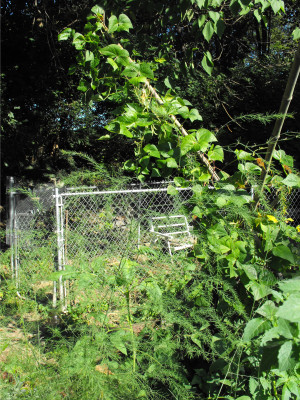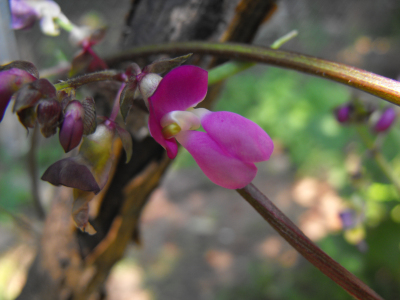
Hidasa Shield Figure and Cherokee Trail of Tears beans
 Two
different types of pole beans are gradually stopping blooming in my
garden now. Both I got from Deni and Tom Peterson at a seed
exchange this
winter. Both I've grown on bamboo "tipis", with the Hidasa Shield
Figure
Bean, from the Plains, further away from the mulberry trees that
shade that part of the garden, which was a bad tomato
blight spot last
year.
Two
different types of pole beans are gradually stopping blooming in my
garden now. Both I got from Deni and Tom Peterson at a seed
exchange this
winter. Both I've grown on bamboo "tipis", with the Hidasa Shield
Figure
Bean, from the Plains, further away from the mulberry trees that
shade that part of the garden, which was a bad tomato
blight spot last
year.
The Hidasa Shield Figure
Beans are rather flat and wide, a light green, and sturdy.
The dried beans are white, with a brown "shield" which also has a white
center in it. According to the Petersons (at
tpeterson@asdevelp.org) they
were grown in Buffalo Bird Woman's Garden, and were selected to Slow
Food's "Ark of Taste." They grew really well and traveled onto a
pea fence
that was next to their poles.
 The
other type, with purple blooms, is the Cherokee Trail of Tears, that
also has a purplish bean that turns green when cooked. Or has the
black
seeds when dried. This has been grown since the late 1830s.
It did well in
partial shade, climbing on poles that slanted back toward the mulberry
branches, so that I, too, had to climb up on a ladder to pick them!
The
other type, with purple blooms, is the Cherokee Trail of Tears, that
also has a purplish bean that turns green when cooked. Or has the
black
seeds when dried. This has been grown since the late 1830s.
It did well in
partial shade, climbing on poles that slanted back toward the mulberry
branches, so that I, too, had to climb up on a ladder to pick them!
The only drawback to
these beans is their strings, with the Hidatsa bean
pods being quite tough to break, while the Cherokee are almost
stringless, with an infinitesimal string, almost as tender as a corn
silk!
No bugs at all on these
beans, compared to Blue Lake, I also grew.
Conventional "half-runners" had much more persistent strings, too.
To grow these beans is to
touch history, in a spiritual way.
| This post is part of our Urban Homesteading lunchtime series.
Read all of the entries: |
Want more in-depth information? Browse through our books.
Or explore more posts by date or by subject.
About us: Anna Hess and Mark Hamilton spent over a decade living self-sufficiently in the mountains of Virginia before moving north to start over from scratch in the foothills of Ohio. They've experimented with permaculture, no-till gardening, trailersteading, home-based microbusinesses and much more, writing about their adventures in both blogs and books.
Want to be notified when new comments are posted on this page? Click on the RSS button after you add a comment to subscribe to the comment feed, or simply check the box beside "email replies to me" while writing your comment.

Hi Anna,
Are you growing these beans for dried/storage type beans or eat fresh from the garden (or freeze), Which type do you like best for either?
Thanks Alison
My mom was growing these for green beans. That said, I personally think that Masai beans are the very best bean for green beans --- they're a French filet bean, so they stay small and sweet with no strings and barely any bean inside. They also are very good frozen.
I'm still figuring out the best dried beans to grow --- I'll keep you posted!